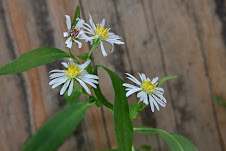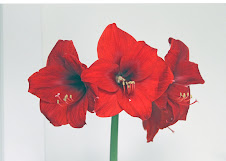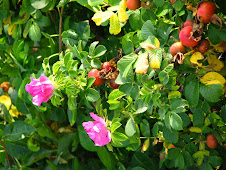October is a good time to plant bulbs, both in your garden and in pots. If planting bulbs in clay soil you should work bone meal, top soil and hardwood mulch into the soil. Use bulb-tone if you have animals which will be attracted to the bone meal and dig up your newly planted bulbs. Do not plant your daffodil bulbs until after the first hard frost. After the second hard frost, plant tulip bulbs. Follow with muscari and crocus bulbs.
For indoor pleasure, force daffodil, tulip, crocus, and hyacinth bulbs. Place your potted bulbs in a dark and cool location until green life appears. Then move to a sunny location where you can enjoy the blooms during the winter gloom. After blooming, let the bulbs dry; then store in a cool dark place. Plant these bulbs in your garden the following spring. Forced paperwhites usually do not bloom after being planted in your garden. However, I still plant them each year. So far with no luck, however, a friend has one batch of paperwhite bulbs which bloom every spring. We think one reason may be that the bulbs are planted close to a black top driveway, which keeps the soil warm in the winter. Do you know how to get paper whites to re-bloom?
October is the time to winterize your roses by applying potassium. Stop deadheading your roses so rose hips can form. The rose hips signal the roses that this is the time to go dormant. Give the roses a final deep water then mulch to protect their soil from freezing.
When the tree leaves start to show color begin to transplant and plant roses, shrubs and trees.
Mid-Oct should be your last fertilizing of shrubs and trees. Only fertilize English box every two or three years.
During the winter your garden mulch will continue to break down, improving the soil’s nutrient value and structure. However, as the shredded bark mulch decomposes it will deplete the nitrogen in your soil. If you used shredded bark as your mulch; you will need to add cottonseed meal or blood meal to your soil. Another way to add nitrogen to your garden is to plant a winter cover crop of clover or rye.
Before the first frost, dig up your sweet potatoes. Also pick your green tomatoes. Put up wind protectors if you have planned a winter veggie garden. Winter veggie gardens are my favorite. No insects. No foraging animals – except deer. Weed less. No sweating.
Enjoy the color of the dying leaves which was brought to us by last weekend’s cold weather.
Saturday, October 24, 2009
Thursday, October 15, 2009
Climate Change
There are actions we can to do to improve the environment for ourselves, our children, and our grandchildren. Recycling, green gardening, and a decrease in consumerism will improve the water we enjoy, the air we breathe and the stress we experience. It is not necessary to believe in climate change to want to improve life on earth.
Recycle newspaper by using as mulch for garden and by adding to our compost pile.
Add more flowers and vegetables to your lawn to decrease the amount of grass area which demands more work and fertilizer. Use beneficial insects and nematodes rather than toxic insecticides.
Drive less; carpool, bike, and walk more. Support alternative energy: wind mills, solar, and hybrid cars. Support thrift stores, yard sales, and farmers markets.
Today I’m participating in Blog Action Day (Oct. 15th) as one of the numerous ways to help.
Recycle newspaper by using as mulch for garden and by adding to our compost pile.
Add more flowers and vegetables to your lawn to decrease the amount of grass area which demands more work and fertilizer. Use beneficial insects and nematodes rather than toxic insecticides.
Drive less; carpool, bike, and walk more. Support alternative energy: wind mills, solar, and hybrid cars. Support thrift stores, yard sales, and farmers markets.
Today I’m participating in Blog Action Day (Oct. 15th) as one of the numerous ways to help.
Subscribe to:
Comments (Atom)



















LP_gardening_2666.jpg)
LP_gardening_2668.jpg)

LP_garden_2819.jpg)

LP_flower_0563.jpg)
LP_flower_0577.jpg)
LP_flower_0545.jpg)
LP_flower_0555.jpg)
LP_flower_0539.jpg)
LP_dog_0470.jpg)
LP_snow_0467.jpg)
LP_dog_0349.jpg)
LP_tree_8153.jpg)
LP_5028.jpg)
LP_flowers_3940.jpg)

LP-grass_0889.jpg)
LP_redfox_1651.jpg)
LP_squirrel_6978.jpg)
LP_flower_6936.jpg)
LP_squirrel_6864.jpg)
LP-deer_4773.jpg)
LP_4521.jpg)
LP_1251.jpg)
LP_4585.jpg)
LP_3784.jpg)
LP_3759.jpg)
LP_3811.jpg)
LP_3816.jpg)
LP_3847.jpg)
LP_0870.jpg)
LP_4183.jpg)
LP_0891.jpg)
LP_3175.jpg)
LP_3577.jpg)

LP_3068.jpg)
LP_3058.jpg)
LP_3562.jpg)
LP_0118.jpg)
LP_3407.jpg)
LP_3150.jpg)
LP_3011+(2).jpg)
LP_3020.jpg)
LP_2830.jpg)
LP_2782.jpg)
LP_2828.jpg)
LP_1746.jpg)
LP_2648.jpg)
LP_2666.jpg)
LP_2668.jpg)
LP_2493.jpg)
LP_2611crop.jpg)


LP_2588.jpg)






LP_2126.jpg)
LP_2122.jpg)





